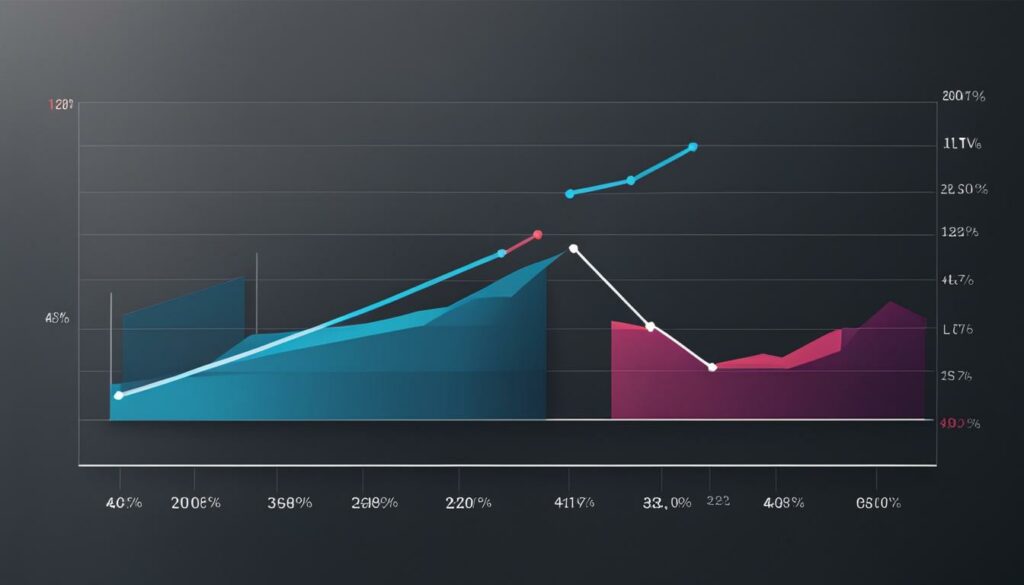Welcome to my article on the topic of LTV in ecommerce. In this digital era, understanding the concept of Long-Term Value (LTV) is crucial for the success of any ecommerce business. LTV, or Customer Lifetime Value, is a metric that predicts the total revenue a business can expect from a customer throughout their relationship with the brand. By harnessing the power of LTV, ecommerce businesses can make informed decisions about customer acquisition, retention, and overall growth strategies.
So, what does LTV in ecommerce really mean? It measures the projected total revenue a business can anticipate from a customer, by taking into account their purchase history, frequency, and relationship duration. This metric goes beyond simply evaluating short-term profits and focuses on the long-term value that each customer brings to the business.
Key Takeaways:
- LTV is a crucial metric in ecommerce that measures the total expected revenue from a customer over the course of their relationship with a brand.
- Understanding LTV helps businesses make informed decisions about acquisition, retention, and marketing strategies for long-term growth.
- LTV encompasses factors such as purchase frequency, average order value, and customer lifespan.
- Calculating LTV involves multiplying the average order value, purchase frequency, and customer lifespan.
- The LTV to CAC ratio is an important metric that illustrates the relationship between customer value and acquisition cost.
The Significance of LTV in Measuring Customer Value and Business Growth
LTV, or Customer Lifetime Value, plays a pivotal role in determining the value of a customer as well as the growth potential of a business in the world of ecommerce. By understanding the ongoing worth of each customer, ecommerce businesses can make informed decisions about acquisition, retention, and marketing strategies. LTV facilitates effective financial planning, enables wise allocation of resources, and optimizes profit margins. It is crucial for customer acquisition, customer retention, resource allocation, and long-term business planning.
When it comes to the importance of LTV in ecommerce, several examples highlight its significance. Repeat purchases, customer loyalty, and sustainability are key aspects of LTV. Repeat purchases from loyal customers contribute significantly to the revenue stream. This steady stream of revenue not only sustains the business but also allows for better forecasting and budgeting. Furthermore, customer loyalty leads to a higher likelihood of future purchases, referrals, and brand advocacy, increasing the overall LTV of a customer.
“Understanding the true value of each customer empowers ecommerce businesses to make data-driven decisions, optimize marketing efforts, and drive long-term growth. LTV is the cornerstone of sustainable success in the ecommerce industry.” – Jason Summers, CEO of Ecomm Solutions
Moreover, LTV serves as a barometer for the health of a business and its growth potential. By analyzing LTV metrics, businesses can identify areas for improvement and implement strategies to enhance customer value. This includes investing in customer acquisition and retention programs, enhancing the customer experience, and providing personalized marketing initiatives. By prioritizing LTV in decision-making processes, ecommerce businesses position themselves for long-term success and profitability.

| Key Components of LTV | LTV Examples |
|---|---|
| Purchase frequency | Customers who frequently make purchases contribute to a higher LTV. |
| Average order value | Customers who spend more per transaction increase their LTV. |
| Customer lifespan | Customers who maintain a longer relationship with a business have a higher LTV. |
Key Components of LTV
In order to understand and calculate LTV in ecommerce, it’s important to consider the key components that contribute to its calculation: purchase frequency, average order value, and customer lifespan. These factors play a significant role in determining the overall worth of a customer and can provide valuable insights for developing strategies to enhance LTV.
- Purchase Frequency: This component measures how often customers make purchases within a given period. It reflects the level of engagement and loyalty of the customer, indicating their willingness to make repeat purchases. By analyzing purchase frequency, ecommerce businesses can identify patterns and trends in customer behavior, allowing them to tailor their marketing efforts and retention strategies accordingly.
- Average Order Value: The average order value represents the average amount of money a customer spends per transaction. A higher average order value indicates that customers are making larger purchases, which can significantly impact their overall lifetime value. Increasing the average order value can be achieved through effective upselling and cross-selling strategies, personalized recommendations, and the provision of exceptional customer experiences.
- Customer Lifespan: Customer lifespan refers to the average length of time a customer maintains a relationship with a business. This component provides insights into customer loyalty and retention. By understanding how long customers continue their engagement with a brand, ecommerce businesses can implement measures to extend customer lifespans and increase overall LTV. This can include loyalty programs, targeted marketing campaigns, and proactive customer service.
By carefully analyzing and optimizing these key components, ecommerce businesses can enhance customer lifetime value, drive long-term growth, and foster sustainable success in the competitive ecommerce landscape.
How to Calculate LTV in Ecommerce
Calculating LTV in ecommerce is relatively simple. It involves multiplying three key components: the average order value, average purchase frequency, and customer lifespan. By combining these factors, ecommerce businesses can measure the long-term value that customers bring to their brand.
Let’s break down the calculation:
- Average Order Value: This represents the average amount of money a customer spends per transaction. It is derived from dividing the total revenue by the number of orders.
- Average Purchase Frequency: This metric measures how often customers make purchases within a given time period. It is obtained by dividing the total number of orders by the number of unique customers.
- Customer Lifespan: This refers to the average length of time a customer maintains a relationship with a business. It is determined by analyzing customer churn rate and retention data.
Once you have these three components, the LTV can be calculated by multiplying the average order value, average purchase frequency, and customer lifespan.
For example, consider a business with an average order value of $50, customers making four purchases per year, and an average customer lifespan of three years:

LTV = Average Order Value × Average Purchase Frequency × Customer Lifespan
Let’s plug in the numbers:
LTV = $50 × 4 × 3 = $600
Based on this calculation, the LTV for each customer would be $600. This information is essential for ecommerce businesses to make data-driven decisions regarding budgeting, resource allocation, customer acquisition strategies, and improving customer experiences.
By accurately measuring LTV, ecommerce businesses can optimize their operations, enhance customer relationships, and drive long-term growth in the competitive ecommerce landscape.
The LTV to CAC Ratio: Understanding its Importance
The LTV to customer acquisition cost (CAC) ratio is a critical metric in ecommerce. It illustrates the relationship between the value of a customer over their lifetime (LTV) and the cost to acquire that customer (CAC). A healthy LTV to CAC ratio, such as 3:1, indicates that for every dollar spent on customer acquisition, three dollars are generated in revenue.
Monitoring and optimizing this ratio helps businesses make critical decisions for sustainable growth, such as ensuring profitable customer acquisition and retaining valuable customers.

The LTV to CAC ratio is a fundamental measure that allows businesses to evaluate the effectiveness of their customer acquisition strategy and its impact on long-term revenue generation. It provides valuable insights into the efficiency and profitability of customer acquisition efforts.
By tracking the LTV to CAC ratio, ecommerce businesses can:
- Identify the most cost-effective and revenue-generating customer acquisition channels
- Optimize marketing budgets by allocating resources to channels that yield higher returns
- Make informed decisions about investing in customer acquisition, retention, and loyalty programs
- Assess the overall profitability of acquiring specific customer segments
A higher LTV to CAC ratio indicates that a business is effectively acquiring customers whose lifetime value exceeds the cost of acquisition. This suggests that the business is maximizing revenue from its customer base and has the potential for sustainable growth.
On the other hand, a lower LTV to CAC ratio may indicate that customer acquisition efforts need optimization. It may be necessary to review the marketing strategy, adjust targeting, refine messaging, or enhance customer retention efforts.
To improve the LTV to CAC ratio and drive long-term success, ecommerce businesses should focus on implementing best practices:
- Targeting the right audience: Ensure that marketing efforts are directed towards the target audience with the highest potential for long-term value.
- Investing in customer retention: Develop strategies to nurture existing customers, build loyalty, and increase customer lifetime value through personalized experiences, loyalty programs, and exceptional customer service.
- Optimizing conversion rates: Continuously refine marketing campaigns to improve conversion rates and reduce customer acquisition costs, maximizing the return on investment.
- Measuring and analyzing data: Regularly evaluate and analyze data to gain insights into customer behavior, preferences, and revenue generation potential. Use this information to refine marketing strategies and enhance customer experiences.
By understanding the importance of the LTV to CAC ratio and implementing best practices, ecommerce businesses can effectively allocate resources, enhance customer acquisition efforts, and maximize long-term revenue generation.
Factors Affecting LTV in Ecommerce
Increasing LTV in ecommerce requires understanding the various factors that influence customer lifetime value. By taking strategic measures and implementing best practices, businesses can optimize LTV and create a loyal customer base.
1. Product Pricing
Product pricing plays a crucial role in encouraging repeat purchases and increasing customer lifetime value. Offering competitive prices and discounts can incentivize customers to make more frequent purchases, boosting their overall value to the business.
2. Effective Marketing Strategies
Implementing effective marketing strategies, such as targeted advertisements, email campaigns, and social media promotions, can significantly impact LTV. By reaching the right audience and enticing them with relevant offers, businesses can increase customer engagement and encourage repeat purchases.
3. Customer Retention and Loyalty Programs
Retaining existing customers is essential for maximizing LTV. Implementing loyalty programs, offering exclusive discounts, and providing personalized recommendations can foster customer loyalty and incentivize repeat business.
4. High-Quality Customer Service
Delivering exceptional customer service is a key driver of customer satisfaction and loyalty. Resolving customer queries promptly, offering hassle-free returns, and providing personalized support can enhance the overall customer experience and increase long-term value.
5. Personalization, Cross-Selling, and Upselling
Personalizing the customer experience, leveraging cross-selling techniques, and implementing upselling strategies are effective ways to increase the average order value and maximize customer spending. By recommending relevant products and showcasing value-added offerings, businesses can increase customer satisfaction and boost LTV.
By considering these factors and incorporating them into their ecommerce strategies, businesses can unlock the full potential of customer lifetime value and drive sustainable growth.
How Good Customer Service Affects LTV
Good customer service plays a crucial role in increasing LTV in ecommerce. It not only boosts customer satisfaction but also encourages customer loyalty and prevents customer churn. By providing outstanding customer service, businesses can create a positive and memorable customer experience that leads to repeat purchases, customer loyalty, and ultimately, a higher LTV.
When customers receive excellent service, they feel valued and appreciated, which enhances their overall satisfaction with a brand. Satisfied customers are more likely to remain loyal and continue making purchases, increasing their LTV. Additionally, they are also more likely to recommend the brand to others, further expanding its customer base and driving long-term growth.
Customer service not only impacts LTV directly but also affects other important ecommerce metrics. For instance, providing exceptional customer service improves customer retention rates. When customers have positive experiences and receive timely support, they are more likely to stay engaged with a brand, leading to higher customer retention rates.
Moreover, good customer service also enhances the brand’s reputation. Satisfied customers are more likely to leave positive reviews and recommend the brand to others, building a strong reputation in the market. A positive brand reputation attracts new customers, increasing the overall customer base and potentially boosting LTV.
“Great customer service is the lifeblood of any business. It creates loyalty, enhances brand reputation, and ultimately drives higher LTV.” – Jessica Anderson, Customer Service Expert
By prioritizing good customer service, businesses not only improve their LTV but also establish a competitive edge in the market. Customers have more choices than ever before, and exceptional customer service can set a brand apart from its competitors.
Maximizing LTV through Excellent Customer Service: Best Practices
- Train customer service representatives to handle inquiries and resolve issues promptly and courteously.
- Implement a customer feedback system to collect insights and address customer concerns effectively.
- Create personalized interactions by using customer data to understand individual preferences and needs.
- Offer proactive support by anticipating customer needs and providing relevant information or solutions in advance.
- Invest in a multichannel customer service strategy to ensure accessibility and convenience for customers.
By following these best practices, businesses can deliver exceptional customer service experiences that nurture customer relationships, increase customer satisfaction, and ultimately drive higher LTV.
The Path to Increasing LTV: Strategies and Best Practices
Increasing customer lifetime value (LTV) in ecommerce requires a strategic approach and the implementation of best practices. One effective strategy is personalization, tailoring the shopping experience to each customer’s preferences and needs. By offering personalized product recommendations and targeted marketing campaigns, businesses can enhance customer satisfaction and drive repeat purchases.
Loyalty programs are another valuable tool for boosting LTV. Rewarding customers for their continued support and incentivizing them to make additional purchases can lead to increased loyalty and higher overall customer value. These programs can take the form of exclusive discounts, special offers, or even a tiered rewards system, encouraging customers to spend more and stay engaged.
Cross-selling is also an effective technique for maximizing LTV. By recommending additional products or complementary items at the point of purchase, businesses can increase the average order value and encourage customers to explore a broader range of offerings. This can contribute to both immediate and long-term revenue growth.
Exceptional customer service plays a crucial role in LTV as well. Providing prompt and personalized support, resolving any issues or concerns, and offering a seamless shopping experience can foster customer loyalty and drive repeat business. Happy customers are more likely to become brand advocates, referring others to the business and further increasing LTV.
While implementing these strategies, it is important to consider the challenges that may arise. Rising customer acquisition costs can impact the profitability of acquiring new customers, making it essential to focus on retaining and nurturing existing ones. Additionally, businesses must continuously seek opportunities for improvement in customer experiences, ensuring that each interaction is positive and memorable. By addressing these challenges and focusing on enhancing LTV through effective strategies and best practices, ecommerce businesses can achieve sustained growth, profitability, and long-term customer satisfaction.
FAQ
What is LTV in Ecommerce?
LTV stands for Long-Term Value in Ecommerce. It refers to the total expected revenue from a single customer over the course of their relationship with a brand.
Why is LTV important in measuring customer value and business growth?
LTV is important because it provides insights into the ongoing worth of each customer, which allows ecommerce businesses to make informed decisions about acquisition, retention, and marketing strategies. It facilitates financial planning, resource allocation, and optimizes profit margins.
What are the key components of LTV in ecommerce?
The key components of LTV in ecommerce are purchase frequency, average order value, and customer lifespan. These factors contribute to the overall worth of a customer and can be used to analyze customer base and develop strategies to enhance LTV.
How do you calculate LTV in ecommerce?
To calculate LTV in ecommerce, multiply the average order value, average purchase frequency, and customer lifespan. This calculation helps businesses make strategic decisions regarding budgeting, customer acquisition, and retention strategies.
What is the LTV to CAC ratio and why is it important?
The LTV to CAC ratio illustrates the relationship between the value of a customer over their lifetime (LTV) and the cost to acquire that customer (CAC). Monitoring and optimizing this ratio helps businesses make critical decisions for sustainable growth, such as ensuring profitable customer acquisition and retaining valuable customers.
What factors can influence LTV in ecommerce?
Factors that can influence LTV in ecommerce include product pricing, marketing strategies, customer retention and loyalty programs, high-quality customer service, personalization, cross-selling, and upselling techniques.
How does good customer service affect LTV in ecommerce?
Good customer service plays a crucial role in increasing LTV in ecommerce. It boosts customer satisfaction, encourages customer loyalty, and prevents customer churn. By providing outstanding customer service, businesses can create a positive customer experience that leads to repeat purchases, loyalty, and a higher LTV.
What are the strategies and best practices for increasing LTV in ecommerce?
Strategies and best practices for increasing LTV in ecommerce include implementing personalization, loyalty programs, cross-selling, exceptional customer service, and community building. It is important to consider challenges such as rising customer acquisition costs and the need for continuous improvement in customer experiences.
